MARIANI’S
January 1, 2006
NEWSLETTER
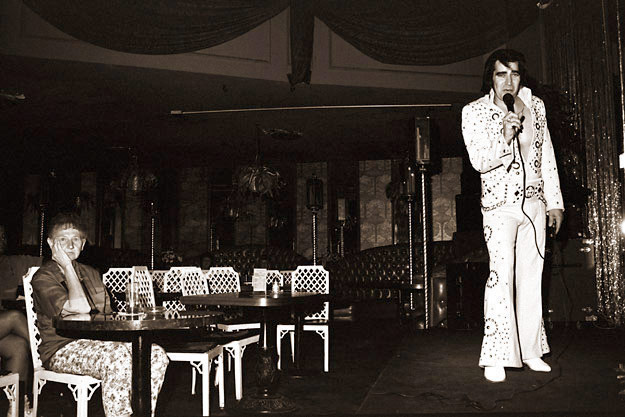
GOODBYE TO 2005! HAPPY NEW YEAR!
UPDATE: To
go to my web site, in which I will update food
&
travel information and help link readers to other first-rate travel
& food sites, click on: home page
ACCESS TO
ARCHIVE: Readers may now access
an
Archive of all past newsletters--each annotated--dating back to July,
2003, by simply clicking on www.johnmariani.com/archive
.
NEW
FEATURE! You may now subscribe anyone you wish
to this newsletter by
clicking here.
In
This Issue
Auf Wiedersehen to The Berghoff! by John Mariani
NEW YORK CORNER: Momoya by John Mariani
QUICK BYTES
WAY AWAY IN THE TURKS & CAICOS
by John Mariani
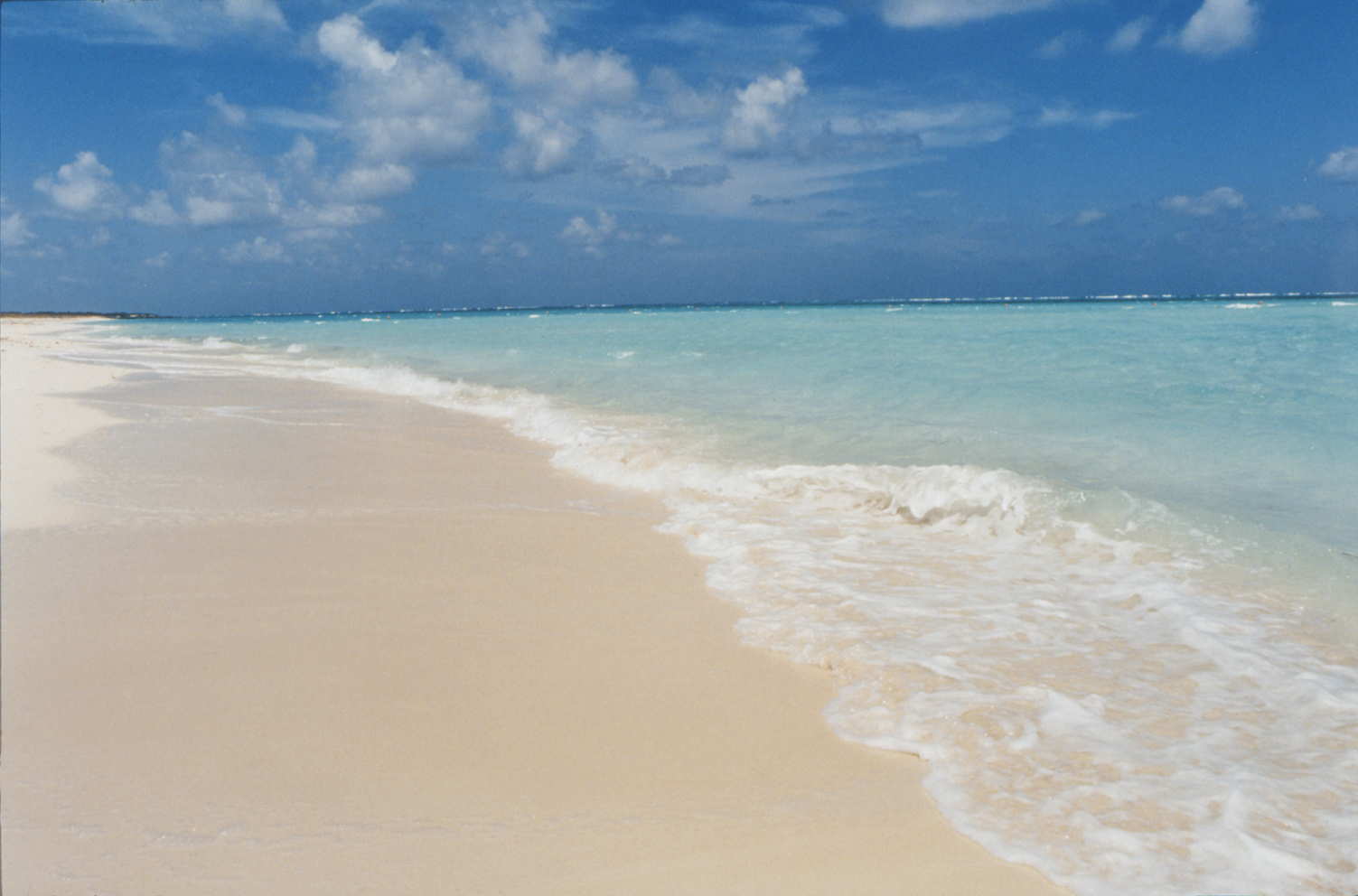
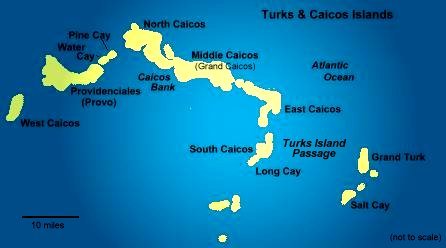
Depending on what source you go to, there are between 30 and 45 islands and cays, many uninhabited, spread over 200 square miles and surrounded by a continuous coral reef. They are under British protection and recognized as a welcoming tax haven. It's believed that one of the islands was where Columbus first made landfall in 1492, and most of the cays look about the way he found them, desolate, quiet and oblivious to civilization. Otherwise, on the bigger islands, you'll run into something like 19,000 people, most of them these days involved in the tourist industry.
One of the more remote cays, though easily reached within 35 minutes from the principal town of Providenciales (called Provo by the locals), is Parrot Cay, which is wholly dominated by a resort of the same name. The resort ferries people back and forth a few times a day, and when you arrive, you take a quick drive up to Parrot Cay and Shambhala Retreat (649-946-7788; click here) where you will be greeted by extremely affable people, many of them Balinese who have been trained and brought over by the owner, who resides in Singapore.
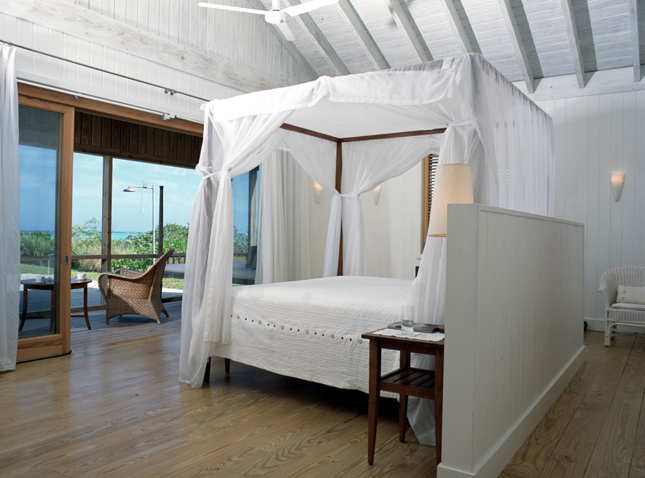 The
resort rambles up and down ruggedly
landscaped hills, and the outer cottages on the beach are reached by
golf carts. Most of the cottages are done in whitewashed teak wood,
with billowing fabrics and slatted doors (left). The Beach Houses have
one bedroom, verandahs, and their own plunge pools, while the Beach
Villas have kitchenettes, and the Parrot Cay Estate is an enclave of
five 3-bedroom villas with swimming pools and private butler service. Winter
rates go from $590 to $4,800 per night. There is internet service available and
free use of computers, and
unless you don't mind paying a small fortune to make a telephone call
(cell
phones don't work here), you're better off e-mailing.
The
resort rambles up and down ruggedly
landscaped hills, and the outer cottages on the beach are reached by
golf carts. Most of the cottages are done in whitewashed teak wood,
with billowing fabrics and slatted doors (left). The Beach Houses have
one bedroom, verandahs, and their own plunge pools, while the Beach
Villas have kitchenettes, and the Parrot Cay Estate is an enclave of
five 3-bedroom villas with swimming pools and private butler service. Winter
rates go from $590 to $4,800 per night. There is internet service available and
free use of computers, and
unless you don't mind paying a small fortune to make a telephone call
(cell
phones don't work here), you're better off e-mailing.As I noted, the service is affable but still has a way to go until I'd call it smooth, and shrugging while chanting the mantra, "Ah, well, this is the Caribbean" is simply not defensible in the 21st century. In one instance a staff member literally came through my verandah door while I was taking a nap, apologizing that he was trying to get into the next room over whose door was locked! So, too, service at the restaurants is very slow: In one instance at lunch, having told the manager I had to be out in 45 minutes, I ended up barreling back to my room and having my meal delivered there because none of it had materialized at the restaurant. This, despite the chef himself sitting at my table and commanding the kitchen that I had an appointment to make.
They are also attempting to build the winelist here--always tough in the Caribbean--and prices are very high as a result.
In speaking with other, regular visitors to Parrot Cay, service has been a problem this year, but the beauty, and reclusivity of the place, is still its principal draw, which is unlikely to be compromised in the future.
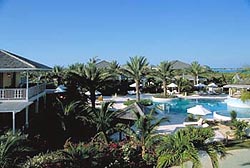 Back in
Provo, Point Grace (left; 866-924-7223; click) takes
its
name from Grace Hutchings, a British woman who apparently did
nothing more than honeymoon here back in 1892, charming the natives
into
naming the hills of the Bight after her. The style here is quite
different from Parrot Cay, with lush vegetation and more of a
traditional Caribbean gingerbread look to it. The restaurant,
Grace's Cottage (below), is
absolutely charming within that style, and serves a
form of continental cuisine with many Caribbean inflections. The
wine list here is among the better ones I've encountered in the
Caribbean, and prices are not quite so out of whack as I have seen
elsewhere.
Back in
Provo, Point Grace (left; 866-924-7223; click) takes
its
name from Grace Hutchings, a British woman who apparently did
nothing more than honeymoon here back in 1892, charming the natives
into
naming the hills of the Bight after her. The style here is quite
different from Parrot Cay, with lush vegetation and more of a
traditional Caribbean gingerbread look to it. The restaurant,
Grace's Cottage (below), is
absolutely charming within that style, and serves a
form of continental cuisine with many Caribbean inflections. The
wine list here is among the better ones I've encountered in the
Caribbean, and prices are not quite so out of whack as I have seen
elsewhere.Sitting outside on the verandah is particularly delightful, with just 62 seats in the whole restaurant. The tables are elegantly set with Baucher china, Sambonet cutlery, and Italian glassware on Egyptian cotton tablecloths--none of which adds a whit of formality to the evening; they just make it all that much more casually elegant. One evening, as occasionally happens, the electricity went out in the area, and the restaurant fell under the spell of candlelight until the resort's generator kicked in. It was quite enchanting during the time it took to restore the lights, probably looking a lot like things did when Mrs. Hutchings visited Provo a hundred years ago.
![]]](gracescottage.jpg)
 The menu changes seasonally but generally
will
have dishes like a West Indian coconut-pumpkin soup with toasted
macadamia nuts; smoked duck salad with roasted cherry tomato and walnut
vinaigrette; seared tuna with yam mash; pan-fried fish with
curried rice pilaf; very good beef tenderloin with truflle-scented
potatoes, and desserts like chocolate soufflé with crème
anglaise. It is easily one of the finer restaurants in the
Caribbean I have had occasion to visit, and the service could not be
more gracious.
The menu changes seasonally but generally
will
have dishes like a West Indian coconut-pumpkin soup with toasted
macadamia nuts; smoked duck salad with roasted cherry tomato and walnut
vinaigrette; seared tuna with yam mash; pan-fried fish with
curried rice pilaf; very good beef tenderloin with truflle-scented
potatoes, and desserts like chocolate soufflé with crème
anglaise. It is easily one of the finer restaurants in the
Caribbean I have had occasion to visit, and the service could not be
more gracious.Auf Wiedersehen to The Berghoff!
by John Mariani
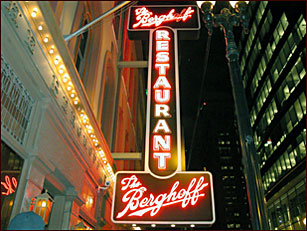 The
closing of a restaurant is unfortunate but a brutal fact of life: six
out of ten close within three years. And longevity alone is not enough
to inspire awe or respect. But the closing of Chicago's historic Berghoff Restaurant on February 28,
2006, is fraught with sadness. For 107 years this grand,
sprawling German restaurant on West Adams Street has been as much an
institution in the Windy City as the White Sox, the great Louis
Sullivan skyscrapers, and the Natural History Museum.
The
closing of a restaurant is unfortunate but a brutal fact of life: six
out of ten close within three years. And longevity alone is not enough
to inspire awe or respect. But the closing of Chicago's historic Berghoff Restaurant on February 28,
2006, is fraught with sadness. For 107 years this grand,
sprawling German restaurant on West Adams Street has been as much an
institution in the Windy City as the White Sox, the great Louis
Sullivan skyscrapers, and the Natural History Museum. "We thank our tremendous staff, the people of Chicago and our customers from around the world who have contributed to our more than 100 years of success," writes Herman Berghoff, 70, paterfamilias and third generation owner, for 53 years, on the restaurant's website (click). "We share the sadness that many feel about the closing of the restaurant. It's been an honor to be part of the fabric of Chicago, but after being in the business for over a half century, [my wife] Jan and I feel that now is the right time to start a new chapter in our lives."
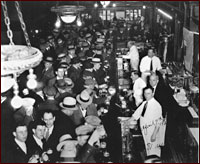
At a time when Chicago had an enormous German population and a an enormous number of German restaurants, Herman Joseph Berghoff opened the Berghoff Café in 1898 to showcase his celebrated Dortmunder-style beer. Originally located at the corner of State and Adams streets, one door down from its present location, the bar sold beer for a nickel and offered sandwiches for free. There was also Schogl's, opened in 1879, famous for its Bavarian-style wine room, Kau's, the Red Star Inn, Old Heidelberg, and the Lincoln Turner Hall Café, where guests were serenaded by a full orchestra playing Strauss waltzes. America's German population peaked by 1900 and two world wars did nothing to help the image of German restaurants, which today are few and far between across the U.S. The Bar when Prohibition Ended
I first went to The Berghoff in the 1970s when it was in full swing, and at the time I was awed by its size, its wonderful decor (much amended over the decades), its stalwart waiters, and the huge portions of good, solid German food, from wursts and sauerbraten to gargantuan sandwiches and apple strűdel, all washed down with German lager and German wines. Over the years I went to The Berghoff whenever I had time in Chicago and it was always the same. You could get creamed herring to start, then broiled Lake Superior whitefish, or Wiener Schnitzel with German fried potatoes, broiled brisket of corned beef with cabbage, pot roast with mashed potatoes, veal Geshnetzles in mushroom sauce, Rahm Schnitzel of pork with a mushroom-sour cream sauce and spaetzle, Jagerschnitzel with a smoked bacon sauce, and its famously flakey chicken pot pie.
The Dining Room in the 1930s
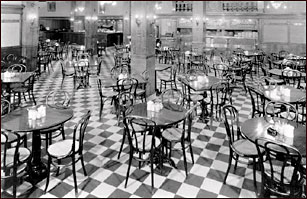 Various non-German items were
always being added to the menu, from pasta to Waldorf salads, but the
core of the kitchen was the kind of food everyone loves but cannot eat
much of any longer. The food of the German immigrants, with all
its largess and Geműtlicheitit spirit, has faded, and now The Berghoff
will too. The
building will be leased to Artistic
Events by Carlyn Berghoff Catering, which intends to provide special
events planning and catering services throughout
the Chicago area. A Berghoff Café will continue to operate
in O'Hare Airport, where you'll be able to get some of the old-style
food. But there won't ever be the joyousness of The Berghoff
again, and that is cause for sadness and for the revival of sentimental
memories everyone who ever went there must surely have of the place.
So many celebrations over so many generations took place here.
Various non-German items were
always being added to the menu, from pasta to Waldorf salads, but the
core of the kitchen was the kind of food everyone loves but cannot eat
much of any longer. The food of the German immigrants, with all
its largess and Geműtlicheitit spirit, has faded, and now The Berghoff
will too. The
building will be leased to Artistic
Events by Carlyn Berghoff Catering, which intends to provide special
events planning and catering services throughout
the Chicago area. A Berghoff Café will continue to operate
in O'Hare Airport, where you'll be able to get some of the old-style
food. But there won't ever be the joyousness of The Berghoff
again, and that is cause for sadness and for the revival of sentimental
memories everyone who ever went there must surely have of the place.
So many celebrations over so many generations took place here. Long after Chicago's trendy new restaurants are long gone, people will still remember The Berghoff as part of their own lives and of the very soul of immigrant Chicago.
NEW YORK CORNER
by John Mariani
Momoya
185 7th Avenue
212-989-4466
Still, despite significant competition in L.A., New York seems to have an extraordinary number—and one that is increasing—of Japanese restaurants, some wholly devoted to sushi, others to the kind of inventive cuisine pioneered by Nobu Matsuhisa at his original restaurant in Beverly Hills, then at the first Nobu in TriBeCa.
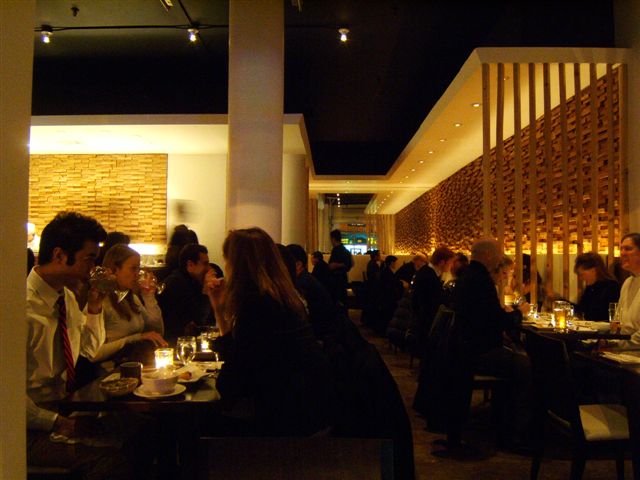 Momoya (which
means "Peach House") takes in both styles and does so
with enormous charm. Too often Japanese
restaurants can be off-putting because of a decided language barrier,
but at
Momoya, chef-owner Chie Shirahata is a cordial and amiable host who is
clearly happy you've honored her with your presence. Her having done
stints at prestigious places like Nobu, Mi, and Obeca Li, pretty much
guaranteed this is not your usual sushi roll-teriyaki eatery.
Momoya (which
means "Peach House") takes in both styles and does so
with enormous charm. Too often Japanese
restaurants can be off-putting because of a decided language barrier,
but at
Momoya, chef-owner Chie Shirahata is a cordial and amiable host who is
clearly happy you've honored her with your presence. Her having done
stints at prestigious places like Nobu, Mi, and Obeca Li, pretty much
guaranteed this is not your usual sushi roll-teriyaki eatery.The restaurant, which replaced another Japanese eatery named Meriken, is set on a corner of Chelsea, a view of which the large windows of the 52-seat dining room, with its 12-foot ceiling, take full advantage. There is a well-lighted 20-foot long sushi marble bar against one wall where three men work amiably at slicing and rolling. The rest of the L-shaped room (left) has pine-covered walls, undraped walnut tables set with fine stemware (hoorah!) and distressing paper napkins (ugh!), and comfy leather seats. This spring there will be an outdoor café.
We arrived on a happily busy evening and could readily tell people were having a very good time. Conversation is easy because the decibel levels are reasonable in the room, despite some unnecessary piped-in music. Waiters in black t-shirts are well trained and knowledgeable about the menu. The wine list is of little consequence but there is a good sake selection.
The menu mixes the traditional with the fresh and contemporary, so you may start off with a fine array of sushi, via Itamae Yasuhior Inoue, in various samplers (from $17.50-$27) or items from the "special roll" section $7-$14), which includes spicy tuna wrapped in seared yellowtail; lobster with avocado, asparagus, red oak lettuce and a spicy salsa; and "fresh spring," made with shrimp, snow crab, avocado, tomato, red onion, and cilantro with sweet-sour chili.
This is one of those menus you want to order everything from so that you can share the wealth, although you might get greedy with some items because they are so good. For appetizers ($2-$10) we chose lustrous sweet miso black cod with spinach and pumpkin and equally pristine fluke done as carpaccio (curious how the word "carpaccio," once reserved for beef, has replaced "sashimi" on many Japanese menus). Shumai shrimp dumplings with ponzu sauce were pleasing and we all craved more. The section labeled "Kitchen," to distinguish it from the sushi offerings, are all cooked, and, at $11-$27, very reasonably priced. Crisp and clean were the items on a tempura tasting of scallop, yuba maki, shrimp, and shrimp stuffed with pumpkin. Broiled eel over rice was a fairly standard rendition. Best of all we tasted was superb broiled Chilean sea bass whose own natural sweetness mingled beautifully with a lemon/miso sauce and spinach.
There are a few desserts here, ranging from warm chocolate cake with shiso syrup and green tea ice cream to orange and coconut crème brûlée with glazed orange, both perfectly o.k.
What is most likable about Momoya is its friendliness and Ms Shirahata's devotion to freshness coupled with culinary imagination. Momoya may not be Nobu, but neither does it charge Nobu's prices, and, unlike the globetrotting Nobu Matsuhisa, Ms. Shirahata believes her place is in her restaurant making sure everything is going as she'd like it.
DEPARTMENT OF CORRECTIONS
Owing to an editing error, a paragraph is Mort Hochstein's story on "25 Italian Wines That Mattered" in last week's issue (click) should have read:
Four of Italy’s greatest wines, not from the Winebow stable—Sassicaia Tenuta San Guido and Ornellaia Masseto, both from Bolgheri, Antinori Tignanello, the latter being the wine that launched the Super Tuscan category, and Gaja Barbaresco Sori Tildin, from the Piedmont are on his list.
WHAT ARE YOUR CRITERIA FOR REVIEWING RESTAURANTS IN THE HOUSTON PRESS?
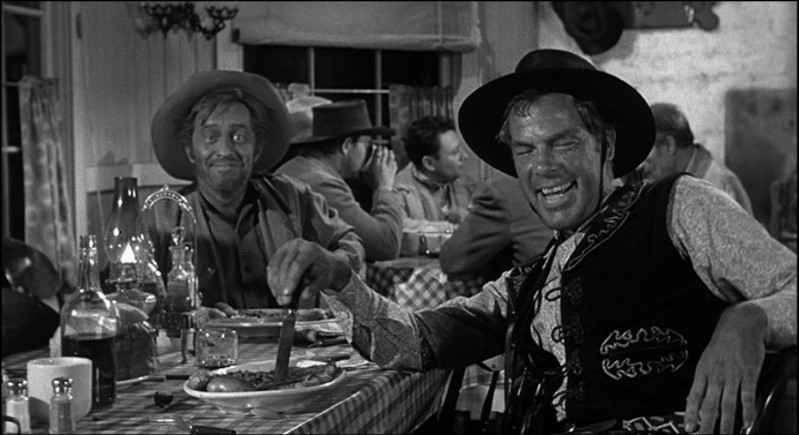
“Domestic beers for $1 and imports for $2 -- that was enough to get me to visit Sabai Thai, a new restaurant in the Metropole Center on Bellaire. They were running the beer special Mondays through Thursdays for happy hour. When we got there on a Monday night in early November, it turned out the offer was good only through the end of October. But thanks to a complete lack of business, the owner agreed to extend the special to the two Tsingtaos I had with dinner.”—Robb Walsh, “All You Need Is Larb,”

WHY, THE SNIVELING LITTLE BASTARDS!
Queen Margaret University College in Edinburgh, Scotland, is blaming Chef Gordon Ramsay for the closure of its culinary school because his TV series "Hell's Kitchen" has shown him swearing at culinary students. Says David Miskin, manager of the school's Food Industry Foundation Board, "Celebrity chefs scare people. Students don't expect to be sworn at."
QUICK BYTES
*
* Ken Frank of La Toque in Rutherford, CA, hold his "24th Annual All Black Truffle" 5-course menu throughout the entire month of January and, nature willing, well into February. It is a 5-course menu with truffles in every course ($135-$160), plus the amuse bouches, a truffled cheese course too. Call 707-963-9770 or visit www.latoque.com.
*On Jan. 22, ten of Charleston’s top chefs and artists will come for the “Chef’s Jacket Auction + Dinner” at Sienna restaurant in Daniel Island, SC, featuring 5 local chefs (Ken Vedrinski, Sienna; Donald Barickman, Magnolia’s; John Marhsall, Al Di La; Patrick Owen, Langdon’s; Mike Lata, FIG) and 5 local artists (Karin Olah, Shannon Smith, Shannon Smith, Will Hegler, Robert Lange, and Jeff Kopish) who will collaborate to craft a concept for the jacket, which the artist will then paint. The chefs will prepare a course that evokes the theme of the jacket, which will be auctioned off, with proceeds to the Gibbes Museum of Art in
* From Feb. 16-19 in
* From Feb. 16-26 The MONTREAL HIGH LIGHTS Festival will feature 50
~~~~~~~~~~~~~~~~~~~~~~~~~~~~~~~~~~~~~~~~~~~~~~~~~~~~~~~~~~~~~~~~~~~~~~~~~
MARIANI'S VIRTUAL GOURMET NEWSLETTER is published weekly. Editor/Publisher:
John Mariani. Contributing Writers: Robert Mariani, Naomi
Kooker, Kirsten Skogerson, Edward Brivio, Mort
Hochstein, Lucy Gordan, Suzanne Wright. Contributing
Photographers: Galina Stepanoff-Dargery, Bobby Pirillo. Technical
Advisor: Gerry McLoughlin.
Any of John Mariani's books below
may be ordered from amazon.com by clicking on the cover image.
 |
 |
 |
 |
 |
 |
copyright John Mariani 2006